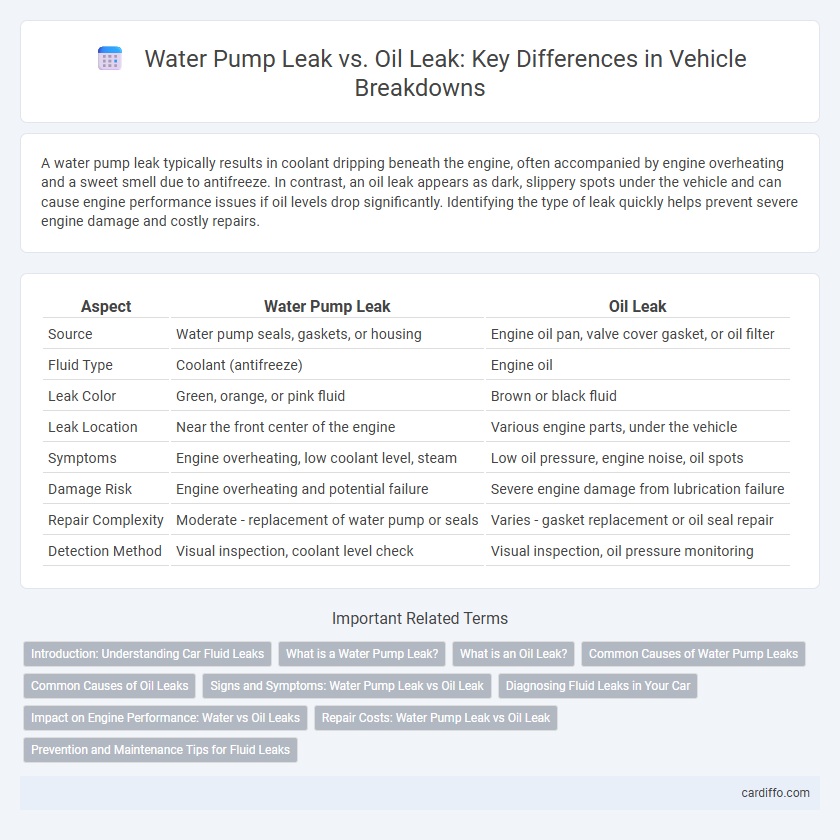A water pump leak typically results in coolant dripping beneath the engine, often accompanied by engine overheating and a sweet smell due to antifreeze. In contrast, an oil leak appears as dark, slippery spots under the vehicle and can cause engine performance issues if oil levels drop significantly. Identifying the type of leak quickly helps prevent severe engine damage and costly repairs.
Table of Comparison
| Aspect | Water Pump Leak | Oil Leak |
|---|---|---|
| Source | Water pump seals, gaskets, or housing | Engine oil pan, valve cover gasket, or oil filter |
| Fluid Type | Coolant (antifreeze) | Engine oil |
| Leak Color | Green, orange, or pink fluid | Brown or black fluid |
| Leak Location | Near the front center of the engine | Various engine parts, under the vehicle |
| Symptoms | Engine overheating, low coolant level, steam | Low oil pressure, engine noise, oil spots |
| Damage Risk | Engine overheating and potential failure | Severe engine damage from lubrication failure |
| Repair Complexity | Moderate - replacement of water pump or seals | Varies - gasket replacement or oil seal repair |
| Detection Method | Visual inspection, coolant level check | Visual inspection, oil pressure monitoring |
Introduction: Understanding Car Fluid Leaks
Water pump leaks typically manifest as coolant puddles beneath the vehicle and can cause engine overheating if not addressed promptly. Oil leaks, identified by dark, oily stains, often lead to decreased lubrication and potential engine damage. Recognizing the distinct symptoms of these fluid leaks is crucial for timely maintenance and preventing costly repairs.
What is a Water Pump Leak?
A water pump leak occurs when the seals or gaskets within the water pump fail, allowing coolant to escape and potentially causing engine overheating. This type of leak is typically found near the timing belt or pulley area, often leaving a visible coolant residue or puddle under the vehicle. Identifying a water pump leak early is crucial to prevent serious engine damage and costly repairs.
What is an Oil Leak?
An oil leak occurs when engine oil escapes from the sealed system, often due to worn gaskets, damaged seals, or cracked engine components. This leak reduces lubrication efficiency, risking engine overheating and increased wear on moving parts. Unlike a water pump leak, which involves coolant and mainly causes overheating, an oil leak compromises engine lubrication and can lead to severe engine damage if not promptly addressed.
Common Causes of Water Pump Leaks
Water pump leaks commonly result from worn-out seals, degraded gaskets, or corrosion within the pump housing, which compromise its ability to contain coolant effectively. Damaged or loose pulley bearings also contribute to leaks by allowing coolant to escape from the pump assembly. Identifying these causes early helps prevent engine overheating and ensures the efficient circulation of coolant throughout the cooling system.
Common Causes of Oil Leaks
Oil leaks commonly result from worn-out gaskets, damaged seals, or loose drain plugs, which allow oil to escape from the engine. Over time, high engine temperatures and pressure contribute to the deterioration of these components, increasing the likelihood of leaks. Contaminated or degraded oil can also compromise seal integrity, accelerating leakage issues and potentially leading to significant engine damage if not addressed promptly.
Signs and Symptoms: Water Pump Leak vs Oil Leak
A water pump leak typically causes coolant pooling under the vehicle and engine overheating due to loss of coolant, while an oil leak results in dark, greasy spots beneath the car and decreased engine lubrication. Signs of a water pump leak include a high-pitched whining noise and steam from the radiator, whereas oil leaks often produce a burning oil smell and visible smoke from the engine bay. Monitoring fluid levels and inspecting the engine for discoloration or residue helps differentiate between these common breakdown symptoms.
Diagnosing Fluid Leaks in Your Car
Water pump leaks often manifest as coolant puddles beneath the vehicle and a noticeable drop in engine temperature, while oil leaks typically result in dark, greasy spots and low oil levels. Diagnosing fluid leaks involves inspecting the color, consistency, and location of the fluid, checking underneath the engine and around seals. Regularly monitoring coolant and oil levels, along with identifying the source of leaks, is crucial to prevent engine overheating or damage.
Impact on Engine Performance: Water vs Oil Leaks
Water pump leaks reduce coolant circulation, leading to engine overheating and potential head gasket failure, which severely impacts engine performance and efficiency. Oil leaks cause lubrication loss, increasing friction and wear on engine components, resulting in decreased power and potential engine seizure. Both leaks compromise engine reliability, but oil leaks typically cause faster and more severe mechanical damage compared to water pump leaks.
Repair Costs: Water Pump Leak vs Oil Leak
Repair costs for a water pump leak typically range from $300 to $750 due to labor-intensive removal and replacement, while oil leak repairs vary widely from $150 to over $1,000 depending on the leak source and severity. Water pump issues often require gasket and seal replacements, increasing parts and labor expenses, whereas oil leaks might necessitate fixing valve cover gaskets, oil pan gaskets, or seals. Diagnosing the exact leak location is critical for accurate cost estimates, with water pump repairs generally more costly due to component complexity and engine access.
Prevention and Maintenance Tips for Fluid Leaks
Regularly inspect hoses, seals, and gaskets to detect early signs of water pump leaks or oil leaks and replace any worn components promptly. Maintain proper fluid levels and use manufacturer-recommended lubricants and coolants to reduce the risk of leaks caused by degradation or contamination. Schedule periodic professional inspections and follow a consistent maintenance routine to ensure the integrity of the water pump and engine seals, preventing costly breakdowns.
Water pump leak vs oil leak Infographic

 cardiffo.com
cardiffo.com